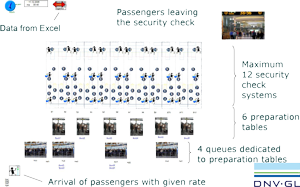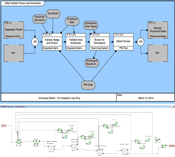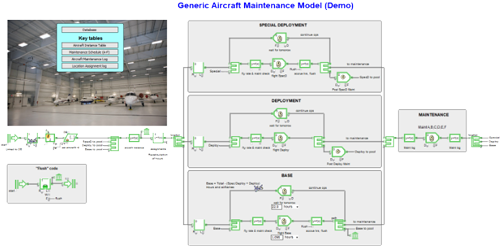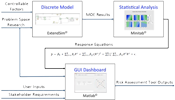Government agencies, departments, and consultants working with the government are discovering simulation is an indispensable tool to help guide them to the best decisions. And ExtendSim has been there to help them every step of the way.
The Naval Postgraduate School uses ExtendSim to educate and train students on the value of modeling and simulation for military use. It's being used for acquisition of supplies, risk assessment, mission analysis, PTSD healthcare delivery, UAV swarm risk assessment, and more.
Battelle, in conjunction with the Center for Disease Control, developed a discrete event simulation model using ExtendSim to evaluate how retail pharmacies affect the influenza vaccine administration capacities in a pandemic.
United States Navy's logistics and sustainment operations to build a supply chain management model addressing gaps in parts support for their new modular design ships. Simulation results indicated that adapting their existing system would be less costly and have lower risk than constructing a new system.

Inventory
Reliability
A consultant for a branch of the US Military is using ExtendSim to build inventory and reliability models of the frequency of failure of parts on military aircraft. Once a part has failed, how does it get replaced and will the replacement part be in inventory or not? And if the aircraft is out of service, will there be another one to replace it?
Defense, Military, & Security Systems Modeling with ExtendSim
- Training.
- Logistics.
- Manufacturing.
- Strategic planning.
- Risk and situation assessment.
- Resource and logistical optimization.
- Pilot studies.
- Time-critical targeting scenarios.
- Analysis of the effects of changes and to validate proposed changes.
- Mission analysis.
- Fleet availability.
- Data communication and prioritization.
- Assess defense weapon systems.
- Design and development of offshore patrol vessels.
- Conduct mine detection, classification, reacquisition, identification, and neutralization.
Who is Using ExtendSim
 DNV GL used ExtendSim to model an airport security checkpoint to analyze its function when the airport was at full capacity. Using data they acquired through video and analysis, they were able to improve the security system based on knowledge of discovering its bottlenecks. They proposed solutions for managing increased capacity which were successfully tested in the simulation model.
DNV GL used ExtendSim to model an airport security checkpoint to analyze its function when the airport was at full capacity. Using data they acquired through video and analysis, they were able to improve the security system based on knowledge of discovering its bottlenecks. They proposed solutions for managing increased capacity which were successfully tested in the simulation model. Lockheed Martin created an ExtendSim model for the Stennis Space Center that estimates the cost of testing rocket engines.
Lockheed Martin created an ExtendSim model for the Stennis Space Center that estimates the cost of testing rocket engines.- ExtendSim is used at numerous aerospace companies like TRW on programs modeling satellites and mission data processing. One particular model simulates more than 3 terabytes of weather sensor data collected by satellites, transmitted to ground stations, and processed into science products.
 The Aircraft Repair and Supply Center in North Carolina plays a unique role in US Coast Guard Aviation by supporting the entire Coast Guard with depot level maintenance and supply support. The HH-65 helicopters conduct missions of search and rescue, enforcement of laws and treaties, including drug interdiction, polar ice breaking, marine environmental protection including pollution control, and military readiness so it is imperative these copters are always on the ready. ExtendSim was used to model the repair and replacement cycle of the HH-65's main gear box. Results suggested process changes to help the Repair Division meet the fleet demand for gear boxes.
The Aircraft Repair and Supply Center in North Carolina plays a unique role in US Coast Guard Aviation by supporting the entire Coast Guard with depot level maintenance and supply support. The HH-65 helicopters conduct missions of search and rescue, enforcement of laws and treaties, including drug interdiction, polar ice breaking, marine environmental protection including pollution control, and military readiness so it is imperative these copters are always on the ready. ExtendSim was used to model the repair and replacement cycle of the HH-65's main gear box. Results suggested process changes to help the Repair Division meet the fleet demand for gear boxes.- Fleets of cargo aircraft in a major war scenario were modeled in ExtendSim to minimize risk to aircraft and personnel.
- An ExtendSim model aided a defense agency to identify choke points accurately and take corrective actions. This work helped increase creditability in aircrew training.
- A consultant for a large defense contractor modeled a training continuum, results of which were one of the important inputs into convincing a customer that changing the training would result in increased throughput, performance, and efficiencies. This led to the customer to agree to a changed training continuum resulting in a significant scope increase for the consulting agency.
 The Canadian Army uses ExtendSim for military logistics and supply chain management.
The Canadian Army uses ExtendSim for military logistics and supply chain management.- Airport Security Agencies evaluate the effects on passenger flow of new airport security checkpoint equipment and procedures with ExtendSim.
 The United States Marine Corps' dependence on fossil fuel leaves logistics fuel support and supply lines vulnerable to attack. Using a specific ship-to-shore vignette, factors were identified and a design of experiments (DOE) analysis was conducted in ExtendSim to assess changes to doctrine, aircraft materiel solution, and environmental conditions that would provide a positive impact on energy efficiency while maintaining or improving operational effectiveness.
The United States Marine Corps' dependence on fossil fuel leaves logistics fuel support and supply lines vulnerable to attack. Using a specific ship-to-shore vignette, factors were identified and a design of experiments (DOE) analysis was conducted in ExtendSim to assess changes to doctrine, aircraft materiel solution, and environmental conditions that would provide a positive impact on energy efficiency while maintaining or improving operational effectiveness.- A defense agency simulated fleets of cargo aircraft in a major war scenario to minimize risk to aircraft and personnel.
- Troop and vehicle movement within a new ship design were modeled in ExtendSim to see how long it would take to outfit and deploy a landing force with their vehicles.
 KLSS built a Depot Process Model for The Boeing Corporation to simulate a wide variety of maintenance depot setups and configurations, starting from the same generic model. The model processes and logically controls the movement of vehicles through a depot according to variable task requirements and the availability of resources (personnel, support equipment, parts, and physical space). As data from an actual depot operation is applied to the model, it assists with the identification of process improvement opportunities which will improve vehicle throughput capacity and platform (tank, aircraft, etc.) availability.
KLSS built a Depot Process Model for The Boeing Corporation to simulate a wide variety of maintenance depot setups and configurations, starting from the same generic model. The model processes and logically controls the movement of vehicles through a depot according to variable task requirements and the availability of resources (personnel, support equipment, parts, and physical space). As data from an actual depot operation is applied to the model, it assists with the identification of process improvement opportunities which will improve vehicle throughput capacity and platform (tank, aircraft, etc.) availability.- ExtendSim has been used for airborne early warning and control
Case Studies
Rob Brownie
Insight Acumen
2022
Have a look at this Aircraft Fleet Maintenance Model built using ExtendSim. The aircraft have a number of attributes one of which is hours on airframe. Model tracks flying hours and routes aircraft to scheduled maintenance events when required by accrued hours. Aircraft can be sent on different types of missions; ie. special deployment, deployment, and local flying operations.
There are six types of scheduled maintenance of different durations. Aircraft are unavailable for deployment or other flying operations while they are in maintenance.
Unscheduled maintenance with Mean Time Between Failures (MTBF) and Mean Time To Repair (MTTR) could also be modelled, but they're not included in this particular demo model.
Key outputs include an aircraft instance table, aircraft maintenance log and location assignment log.
For more customer and concept models, or more on Insight Acumen, visit www.insightacumen.com.au.
Rob Brownie
Insight Acumen
2020
This case study of an aircrew training system model was built using ExtendSim. The model was used to model a high level of detail to test total training system solution proposed to the Army, to improve time to train (ttt) & resource utilization.
Six concurrent curricula (training management packages) were built to the event level with resources (classrooms / instructors / aircraft etc) assigned as required for all events. Three rotary-wing aircraft types were modeled as resources in the training system. Based on model results, the model suggested changes to the course structure (Pilot and Aircrewman) to imporve time to train and resourc utilization resulting in a contract expansion of $44 million dollars.
For more customer and concept models, or more on Insight Acumen, visit www.insightacumen.com.au.
Cost Analysis for Operational and System Level Considerations for an Electromagnetic Railgun on an Amphibious Platform
Christian Diaz, Paul T. Beery, and Anthony G. Pollman
Department of Systems Engineering • Naval Postgraduate School
Presented at the 2021 Winter Simulation Conference
This article investigates outfitting an amphibious platform with an electromagnetic railgun (EMRG), which is a high velocity weapon that can fire projectiles at ranges up to 100 nautical miles. An EMRG would provide the amphibious fleet with offensive capability, as well as defensive capability against surface threats, missiles, and airborne threats. Because the railgun remains in the early stages of development, the Navy’s railgun prototype has been modeled in ExtendSim. Detailed assessment of changes to EMRG design suggest that improvements to the probability of hit of the EMRG has a greater impact on performance than improvements to either cycle time or engagement range. This provides an opportunity for tradeoffs to be made in the design of the railgun and its projectile in which the power requirements (and size) can be scaled down without negatively impacting effectiveness, provided the probability of hit of the projectiles is not reduced.
David E. Hunter, Institute for Defense Analyes
OR/MS Today, August 2015
Because traditional cost estimating relationships have proven inadequate for estimating maintenance manpower for advanced combat aircraft, Institute for Defense Analyses (IDA) researchers developed a discrete-event simulation model in ExtendSim. The IDA Maintenance Estimation and Sortie Utilization Rate Evaluation (IMEASURE) model projects staffing needs within an aircraft squadron for propulsion, airframe, and avionics maintenance technicians.
IMEASURE has become an important tool in providing DoD sponsors with timely, high-quality estimates of life-cycle costs early in an aircraft’s development phase. It has been successfully applied in studies of advanced tactical aircraft, such as the Joint Strike Fighter and the F-22A, and in analyses of the upgraded UH-1 helicopter, the proposed unmanned combat air vehicle, and alternative designs for a new bomber.
This paper was published as a Roundtable Profile article in the August 2015 issue of OR/MS Today and is featured on the IDA in the Research Community .
Cost of Unsuitability: Assessment of Trade-offs Between the Cost of Operational Unsuitability and Research, Development, Test and Evaluation (RDT&E) Costs
Tzee-Nan K. Lo, Project Leader, Harold S. Balaban, Waynard C. Devers, Christopher S. Wait, Kristen M. Guerrera
Institute for Defense Analyses
Between 1984 and 2006, 36 out of the 136 systems that underwent operational test and evaluation (OT&E) were evaluated as unsuitable. In light of this high proportion, in October 2006 the Director, Operational Test and Evaluation, commissioned a study from the Institute for Defense Analyses (IDA) to answer the following two questions:
- When a system is found to be operationally unsuitable, what are the associated costs?
- To what extent can such costs be avoided by addressing unsuitability issues during the System Development and Demonstration (SDD) phase?
Using a small, selected set of Department of Defense acquisition program case studies, the IDA examined three major aircraft plafroms that addressed substandard reliability in different programmatic phases. Using the IMEASURE model and other tools, IDA identified additional resources devoted to improving reliability, the resulting change in reliability, and the corresponding reduction in return.
Team CQ Alpha - Sariyu Marfo, Shane Ehler, Ryan Fields, Jamaries Benitez Negron, Shane Skopak, John Junek, Justin Zarzaca, Robert Perrotta
Naval Postgraduate School
September 2015
This paper examines the need for a UAV Swarm Risk Assessment Tool and how it can assist the Navy’s decision makers in assessing risk of UAV swarm threats in littoral environments near potentially hostile countries, based on the latest intelligence. Human-centered design principles help determine the needs of experienced battle commanders. These needs form the basis of requirements and functional analysis. The system design concept consists of several parts: discrete-event simulation of UAV swarm attacks using ExtendSim, statistical analysis of the simulation data using Minitab, and a graphical user interface (GUI) that evolved as a web-app prototype written in MATLAB. Data from the simulation is analyzed and used to generate equations that calculate the effect of critical factors: physical environment, number of UAVs, distance from land, and the ship’s defensive weapons. The GUI uses these equations to provide users with the capability to vary those critical factors and analyze different courses of action and risk. The physical GUI web-app can be used as-is, tailored or expanded. The paper concludes with an analysis of the actual GUI prototype built for UAV swarm risk assessment and how it meets user needs.
Team SSP, Cohort 311-1240 - Robert Appleton, Jose Casillas, Gregory Scales, Mellissa Niehoff, David Fitzgerald, and David Ouellette
Naval Postgraduate School
June 2014
The Navy requires a capability for effective and efficient entry control for restricted areas that house critical assets. This thesis describes an Advanced Restricted Area Entry Control System (ARAECS) to meet this requirement. System requirements were obtained from existing governing documentation as well as stakeholder inputs. A functional architecture was developed and then modeled using the ExtendSim tool. Factors affecting ARAECS operation were binned into physical, technology, Concept of Operations (CONOPS), and noise. An Overall Measure of Effectiveness was developed and a Design of Experiments (DOE) was conducted to measure the affects of these factors on ARAECS performance. The two main drivers were minimizing security violations while also maximizing personnel and vehicle throughput. Based on the modeling, an architecture was selected that best met system objectives—this architecture relied on the ability to pre-screen 40% of the workforce based on security clearance and thus subject them to reduced random screening. The architecture was documented using the Vitech CORE tool, and use cases were developed and documented. A test and evaluation plan was developed and discussed. Risk was then examined, including technical, schedule, and cost risks.

Exploring the Reduction of Fuel Consumption for Ship-to-Shore Connectors of the Marine Expeditionary Brigade
Stephen "Jack" Skahen
Naval Postgraduate School
December 2013
The Marine Corps must prepare itself to operate without the benefit of readily available fossil fuels and supplies shipped in by trucks or home-based supply lines. As demonstrated in the current conflicts, the threats of IEDs and the expenses of obtaining fossils fuels make it imperative that the Marine Expeditionary Brigade (MEB) of the future must be able to bring its supplies with them or have them delivered by readily available and close-by alternate means. The team chose to build a stochastic model of the notional MEB architecture framework in ExtendSim to research tradeoffs to reduce fuel consumption, while still maintaining mission effectiveness. It was documented that fuel savings are directly proportional to the Seabase distance and sea state effects during operations, which may not always be able to be influenced by the landing force. The model validates planning considerations with respect to SSD and sea state offering statistical evidence to support a recommendation that these two factors should be minimized when practical to gain best efficiencies when conducting the assault.
Daniel Widdis, Principle Operations Research Analyst
CTC Concurrent Technologies Corporation
CTC developed the Total Life Cycle Systems Management (TLCSM) ExtendSim Logistics Analyzer (TESLA) Discrete Event Simulation tool. This tool enables rapid prototyping of life cycle sustainment models, providing both a strong foundation and the flexibility to adapt the model to many specific questions regarding reliability, availability, maintainability, and cost metrics. Originally built to analyze MRAP vehicle fleet throughout the remainder of its life cycle, the tool has been extended to additional analyses including Business Case Analyses for Program Manager, Engineer Systems and Prognostic Forecasting for the Army Material Command’s Condition Based Maintenance directorate.
Since implementation of the new tool, CTC’s analysts have maintained involvement with the Naval Postgraduate School’s Simulation Experiments and Efficient Designs (SEED) Center, enabling them to employ the state-of-the-art in experimental design and analysis of simulation output.
SoSE Modeling and Simulation Approaches to Evaluate Security and Performance Limitations of a Next Generation National Healthcare Information Network (NHIN-2
Missile Defense Agency • Directorate of Modeling and Simulation Verification, Validation, and Accreditation
Jeffrey Strickland, PhD
Predictive Analytics Consultant, Data Science Expert, Author, Speaker, Unfluencer
2010
Modeling the proposed NHIN system design so the actual configuration will have the expected and desirable properties. This approach helps limit wasted programming or deployment resources by detecting and fixing robustness, security, flexibility, safety, or reliability faults early in the design and configuration process. Note, ironically, this model is an adaptation of a model originally configured for potential defense applications.
Booz Allen Hamilton and US Immigration and Customs Enforcement
In a strategic effort to prioritize enforcement and removal operations toward criminal aliens (those individuals illegally present in US with a criminal conviction), Booz Allen Hamilton began supporting Immigration and Customs Enforcement (ICE). Booz Allen’s implementation of analytics spanned three years and involved developing a set of models used to solve challenging problems such as forecasting the number of criminal illegal aliens, optimizing a technology deployment schedule, and minimizing the transportation costs of removal. The impact of the work resulted in a doubling of criminal alien removals, leading to greater public safety for the American people.
In addition, this Booz Allen project, “Enhancing Immigration Enforcement with Decision Analytics” won the Institute for Operations Research and the Management Sciences’ (INFORMS) inaugural Innovation in Analytics Award in 2011.

Implementation of Simulation for Network Service Delivery Point Capacity Analysis
Tiffany Jill Harper, Wright State University
A thesis submitted in partial fulfillment of the requirements for the degree of Master of Science in Engineering
2008
The United States Air Force, in accordance with the Department of Defense's mission to modernize its processes, systems, and information flows, began an effort to replace legacy systems with two Enterprise Resource Planning (ERP) systems. Nova Technology Solutions (NovaTech), an Information Technology (IT) and Analytics firm, recognized the Air Force's need for a repeatable, reliable, tool to aid decision making during the planning, installation, and sustainment of these ERP systems, thus proposing the use of modeling and simulation.
ExtendSim was used to create a simple simulation model to analyze the impact of ERP increased workload on network performance by simulating the flow of data packets, specifically at the Air Force Service Delivery Points (SDPs). Results showed a 15% increase in current workload (or current network traffic) will cause a 250% increase in end-user response time (Fitzgerald & Harper, 2008).
William E. Weiss
The MITRE Corporation
2008 Winter Simulation Conference
The Department of Homeland Security (DHS) commissioned the MITRE Corporation to create an agent-based DES model of airport defense and security systems. Attacker and defense behavior at the airport environment are modeled using two intelligent agents with decision making and learning capabilities. The model simulates the performance of the airport defense against threat vectors (path-weapon combinations) so security can continuously and rapidly adapt to shifting threats.
Matthew W. Lewis, Aimee Bower, Mishaw T. Cuyler, Rick Eden, Ronald E. Harper, Kristy Gonzalez Morganti, Adam C. Resnick, Elizabeth D. Steiner, Rupa S. Valdez
Rand Corporation
Prepared for the United States Navy in 2010
RAND Corporation uses ExtendSim to identify new equipment and maintenance strategies that have the potential to enable the Army to reduce the cost of equipment and maintain its Combat Support Hospitals at fully modernized levels, providing them with equipment that is newer and in better condition.
Susan Hutchins, Gordon Schacher, John Looney, Jack Jensen, John Osmundson, and Shelley Gallup from the Naval Postgraduate School; James Dailey and Steven Saylor from The Boeing Company
10th International Command and Control Research & Technology Symposium
May 2005
Boeing and the Naval Postgraduate School (NPS) developed an ExtendSim model of an organizational concept called Standing Joint Forces HQ (SJFHQ) being developed at the US Joint Forces Command (JFCOM). The modeling objective was to measure personnel utilization and organizational process efficiency. Here is the abbreviated presentation NPS final report and an given at a public command and control conference. The final report contains a lot of information about the actual ExtendSim model developed.
Steven Saylor, The Boeing Company
James Dailey, James Dailey & Associates
Winter Simulation Conference 2010
The Boeing Advanced Logistics Analysis Capabilities Environment (BALANCE) modeling simulation architecture (United States Patent 9372917) was developed in ExtendSim to enable accurate, highly user configurable simulations of complex multi-echelon, multi-part indenture supply chain networks, including sub-assembly and refurbishment. BALANCE provides a standardized, reusable supply chain modeling toolset to support inventory management assessment, performance-based logistics contracts risk assessment, and manufacturing schedule risk assessment. It meets a need for a supply chain and logistics modeling capability that can be applied across a wide spectrum of domains, provides detailed output at the individual supply level, can interface to other logistics and performance analysis tools, can accommodate insertion of custom tailored sub-models for modeling detailed system operations and demand occurrence, and is based on standard commercially available software.
Videos

Satellite Orbiting and Communication Modeling
This SimCast looks at an orbital model, data communication model, and a detailed ground processing model. Doug Shannon of TASC/GreenDart, Inc. and Richard Marymee of GreenDart, Inc. examine polar orbiting weather satellites, stored sensor data, communication links to global receptors, and sensor data retrieval in ExtendSim models. The data retrieval model includes lost data and data recovery due to a rain attenuation model. The ground model is a process flow of sensor data executing simulated weather algorithms on shared data processors.This SimCast was originally presented on March 13, 2014.








 Download Paper
Download Paper


 Visit the Calhoun site to see more research being carried out by the Naval Postgraduate School.
Visit the Calhoun site to see more research being carried out by the Naval Postgraduate School.







